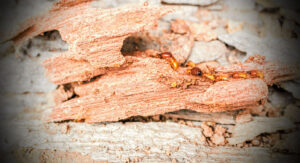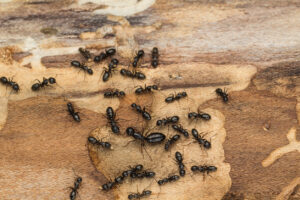Living in the picturesque Pacific Northwest, it’s undeniable that our cities are carved out of a vast natural landscape. We witness the beauty of the seasons—the way old leaves fall and decompose into fertile soil through moisture, changing temperatures, tiny microorganisms, and a diverse array of insects.
However, this natural process isn’t limited to just leaves. We see it in fences, garden sheds, old barns, and those worn corners of our homes and decks where paint has chipped away. Nature is always ready to reclaim its materials—and that includes the wood supporting our homes.

The Hidden Threat to Your Home
Nature doesn’t just reclaim exposed wood; it also finds its way into the unseen areas of our homes, such as floor and roof supports and the voids between our walls. Subterranean termites, dampwood termites, carpenter ants, wood-boring beetles, and fungi quietly break down these structures, causing significant damage over time.
Many of these wood-destroying organisms (WDOs) go unnoticed. Their presence is often indicated by subtle signs, like shelter tubes that resemble cobwebs or fecal pellets that can be mistaken for dirt or rodent droppings.
- Subterranean termites live below ground and travel up through shelter tubes to feed on wood, damaging the lower structural members of the home.
- Dampwood termites thrive in moist conditions and infest areas with earth-to-wood contact. They can start in a crawlspace and spread to the rafters.
- Carpenter ants are often mistaken for “flying ants” and can cause severe structural damage if left undisturbed.
- Wood-boring beetles breed in old, well-seasoned wood in unheated damp spaces and can slowly cause damage if left undisturbed for repeated seasons.
- Fungi decay, though commonly referred to as “dry rot,” is prevalent in our damp environment. It colonizes wood rapidly, turning fallen logs and stumps back into soil. Even minor home maintenance oversights can create conditions that invite fungi to grow on unsealed siding and decks, and where moisture intrusion occurs in attics, crawlspaces, and between walls.
Why Wood-Destroying Organisms Matter in Home Inspections
Oregon’s Standards of Practice for Home Inspectors specifically exclude wood-destroying organisms from the scope of a standard home inspection:
812-008-0204 General Exclusions
(g) The presence or absence of pests such as wood-damaging organisms, rodents, or insects.
However, at HomeCheck Inspection Service, we recognize the critical role WDOs play in the structural integrity of homes. That’s why Jeremy, our lead inspector, has been a licensed Pest Control Applicator through the Department of Agriculture and a member of the Oregon Pest Control Association since becoming an Oregon Certified Home Inspector.
For over 20 years, Jeremy has provided supplemental inspections for WDOs, following the Standards of Practice of the Oregon Pest Control Association. In addition to maintaining his Oregon Certified Home Inspector license, he continuously updates his knowledge of wood-destroying organisms through continuing education courses required for his Department of Agriculture license.

Keeping Your Home Safe
At HomeCheck Inspection Service, we prioritize helping our clients maintain their real estate investments through comprehensive knowledge and thorough inspections. With plenty of wood in Oregon for insects and fungi to consume, it’s essential to keep our homes off the menu.
If you’re buying a home, or want to ensure your current home remains structurally sound, a professional WDO inspection is a key component of a thorough home inspection. Identifying and addressing issues early can save thousands in repairs and provide peace of mind.


